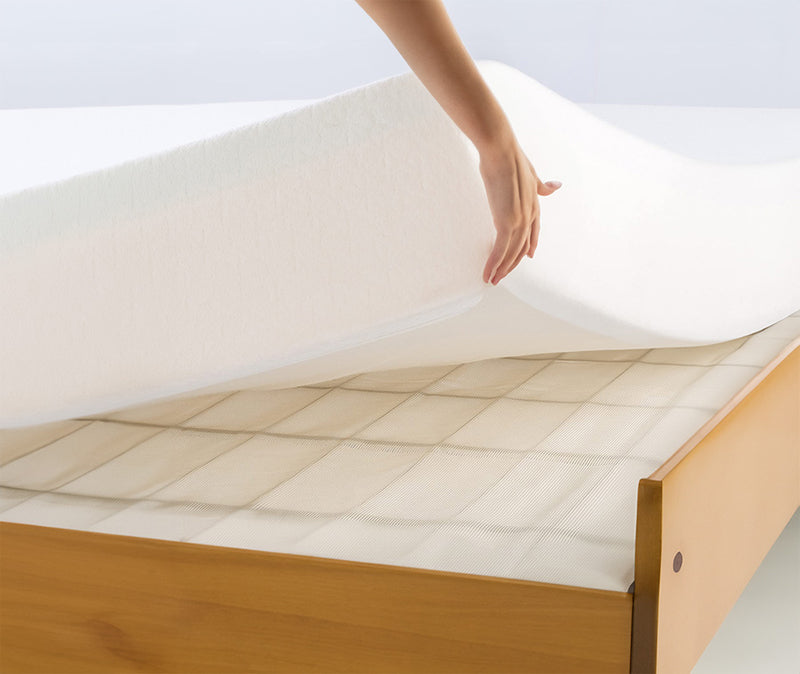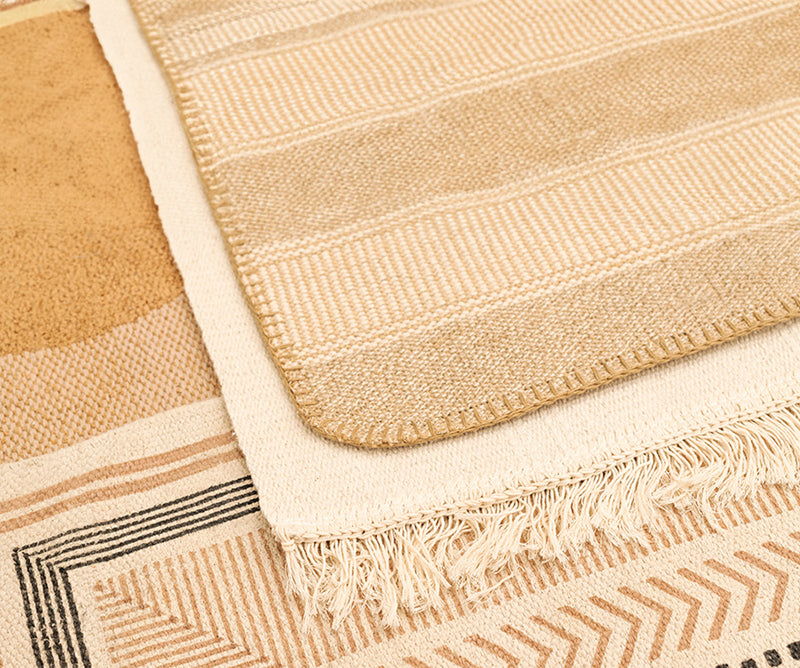No Products in the Cart
Zulekha Nishad, based in India, is a skilled content specialist, copy editor, and creative content writer with a Master's degree in English Language and Literature. Read more
Last Updated August 29, 2024
Have you ever experienced that frustrating moment when you wake up and your mattress has shifted to one side, leaving you wedged uncomfortably against the wall? Or maybe you've noticed your mattress gradually inching its way across the bed frame, creating an annoying gap? If you're nodding in agreement, you're not alone! The struggle of a sliding mattress is a common woe for many. But fear not, because, in this guide, we're going to tackle this issue head-on and equip you with the knowledge to keep your mattress securely in place.

Key Takeaways:
Before we move into solutions to prevent your mattress from sliding, it's essential to pinpoint the underlying causes. Various factors can contribute to this frustrating issue, ranging from the bed frame's design to the age and condition of your mattress. Let's break down each one of them in detail.
One of the primary culprits behind a sliding mattress is an old mattress. As time passes, even the best mattress may lose its original shape and firmness, making it more susceptible to shifting around on your bed frame. The sagging and softening of an older mattress can create a less stable surface for your sleep, allowing it to slide with even the slightest movement.
Another reason is inadequate bed frame support. A flimsy or improperly constructed bed frame can't hold the mattress securely in place, causing it to slide. If your bed frame lacks a robust foundation or center support beam, it can bow or bend under the mattress's weight, leading to unwanted movement.
Sometimes, mattress sizes and the corresponding bed frame sizes don't match up. If your mattress is slightly smaller than the bed frame, there's a greater chance of sliding. The size disparity leaves room for the mattress to shift, especially during restless nights or when getting in and out of bed.
| MATTRESS TYPE | MATTRESS SIZE | BED FRAME SIZE |
|---|---|---|
| Twin | 38 inches x 74 inches | 40 - 43 inches x 77 - 80 inches |
| Twin XL | 38 inches x 80 inches | 40 - 43 inches x 80 - 85 inches |
| Full/Double | 54 inches x 75 inches | 56 - 59 inches x 77 - 80 inches |
| Queen | 60 inches x 80 inches | 62 - 65 inches x 82 - 85 inches |
| Standard King/Eastern King | 76 inches x 80 inches | 78 - 81 inches x 82 - 85 inches |
| California King/Western King | 72 inches x 84 inches | 74 - 77 inches x 86 - 89 inches |
The absence of friction between the mattress and bed frame can also be a contributing factor. Smooth surfaces, like those found on platform beds or metal frames, can encourage mattress movement. When there's nothing to grip onto, your mattress may slowly migrate to one side, leaving you in an awkward sleeping position.
Bed frames without railing or guardrails can lead to mattresses slipping off the edge. This could be problematic if you tend to sleep near the border of the bed. Without a barrier to hold the mattress in place, it can gradually shift and eventually slide off the edge, disrupting your sleep.
Now that we've identified the root causes, let's explore five effective solutions to ensure your mattress stays firmly in place:

Non-slip mattress pads are specially designed accessories made of high-friction materials that create a secure grip between the mattress and the bed frame. They're a smart choice for those looking for a cost-effective alternative to a traditional mattress protector and mattress cover.
To install a non-slip pad, simply place it between the mattress and the foundation or bed frame. This friction-inducing layer significantly reduces mattress movement, ensuring stability during sleep.

Another option to enhance friction and prevent mattress sliding is to use rubber matting. By placing a rubber mattress pad between the mattress and the foundation or bed frame, you can significantly improve grip and stability. It's important to ensure that the rubber mat is of an appropriate size and thickness to provide ample grip for your specific bed setup. You can even cut rubber mats to fit the exact dimensions of your mattress if necessary, making this a cost-effective and customizable solution.

Velcro strips or fasteners can be employed to establish a strong connection between the mattress and the bed frame. By attaching one side of the Velcro strip to the mattress and the other to the frame, you create a reliable bond that prevents horizontal mattress shifting. This method is particularly effective for platform beds and adjustable bed bases, where traditional methods may not be as suitable. Velcro offers a secure yet adjustable solution, allowing you to reposition or remove it as needed.

Rubberized shelf liners, commonly used in cabinets and drawers, offer an economical solution for preventing mattress slippage. Place these liners between the mattress and the bed frame, as they possess anti-skid properties. Their textured surface enhances friction, anchoring the mattress in place.

Rug pad grippers are multifunctional accessories designed to prevent rugs from slipping on floors. These grippers, composed of non-slip materials like rubber or silicone, can be cut to size and placed strategically between the mattress and bed platform or slats. Their high friction coefficient ensures minimal mattress movement.
Mattress extenders and gap fillers are designed to address size disparities between mattresses and bed frames. They not only eliminate gaps that can cause mattress shifting but also offer added stability. These extenders fit securely beneath the mattress, reducing the likelihood of sliding.
A mattress retainer bar is a robust and secure option for preventing mattress movement. Typically integrated into adjustable bed bases, it features a horizontal bar positioned at the foot of the bed. This bar holds the mattress in place, reducing lateral displacement and ensuring a stable sleep surface.
Maintaining a clean sleeping environment is essential for long-term mattress stability. Regularly vacuuming underneath the mattress removes dust, debris, and particles that could contribute to slippage. A clean foundation also facilitates better adhesion with non-slip accessories.
In a nutshell, dealing with a sliding mattress can be a real pain, but armed with the right knowledge and solutions, you can put an end to those restless nights. By addressing factors such as an old mattress, poor support, mattress size disparities, and the lack of friction, you can enjoy a securely positioned mattress and a good night's sleep.
There could be multiple reasons for a mattress slide- the undersurface of the mattress might have become too smooth from regular usage. Or, the mattress size might need to be in sync with your bed size. Or perhaps your bed frame could be missing rails or a mattress retainer bar. Mattress age is another factor that can cause a mattress slip situation.
Yes and no. Before you jump into impulsive buying, you should check whether it's time to replace your mattress.
How do you know it? Well, if you see permanent dimples on its top surface, hear the creaking sound of the springs beneath, and feel its lopsidedness, then it is high time you change it.
Definitely. Treat metal bed frames (or wooden ones) as an investment in your sleep. A bed frame is sturdy, supportive, and best for people who have just moved into a new place.
A sliding mattress can pose several dangers. Firstly, it can disrupt your sleep, causing discomfort and annoyance. More importantly, it can create gaps between the mattress and the bed frame, increasing the risk of accidents like falling off the bed or getting trapped between them.
Non-slip mattress pads or grippers are designed specifically to prevent mattress movement. They typically have a textured surface that grips the mattress and bed frame, reducing sliding significantly. Using these products can provide a reliable and hassle-free solution to the problem.
Yes, some types of mattresses are more prone to sliding than others. Innerspring mattresses with a smoother surface or memory foam mattresses without an adequate base may be more likely to slide. Understanding your mattress type can help you choose the most suitable anti-slip solution.
To prevent a mattress from sliding off a metal bed frame, you can use non-slip mattress pads or grippers designed specifically for this purpose, which can be placed between the mattress and the frame to increase friction and stability.
You can also consider securing the mattress with elastic or adjustable straps or clips at the corners to hold it in place.
Alternatively, opt for a mattress with built-in anti-slip features, like a tacky bottom surface or foam layers that grip the frame better. These measures will help keep your mattress securely in position on a metal bed frame.
If you have spent more than 8 years sleeping on it, the fabric or material on the underside smoothens, can't hold, and helps keep your mattress from sliding. A memory foam mattress often suffers from this problem.
See if mattress straps help fix the issue. Sometimes, mattress extenders help if your mattress is a bit shorter than the bed. And when nothing helps, it's better to get a new one.
While a mattress topper may add some extra weight to your mattress and could potentially reduce minor movements, it's not a reliable or effective solution to prevent significant mattress sliding. To address the issue of a sliding mattress, it's better to use one of the methods mentioned in this article, such as non-slip mattress pads, rubber matting, Velcro strips, rubberized shelf liners, rug pad grippers, mattress extenders, or mattress retainer bars.
Related blog posts:
2. How to Store a Mattress the Right Way
4. How Can You Check If a Latex Mattress is Natural or Not?
5. What is the Best Foundation For a Latex Mattress?
Disclaimer: What is said in this article has been referenced from multiple sources and is intended only for educational and informational purposes. Please note that no content in this article is a substitute for professional advice from a qualified doctor or healthcare provider. Always consult an experienced doctor with any concerns you may have regarding a health condition or treatment, and never disregard any medical suggestions or delay in seeking treatment because of something you read here.
Notify me when available
We will send you a notification as soon as this product is available again.
We don't share your email with anybody


